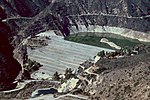California's 26th congressional district
California 26th congressional district is a congressional district in the U.S. state of California currently represented by Democrat Julia Brownley. The district is located on the South Coast, comprising most of Ventura County as well as a small portion of Los Angeles County. Cities in the district include Camarillo, Oxnard, Santa Paula, Thousand Oaks, Westlake Village, Moorpark, and part of Simi Valley. In 2022, the district lost Ojai and most of Ventura and added Calabasas, Agoura Hills, and the sparsely populated northern half of Ventura County.From 2003 to 2013, the district spanned the foothills of the San Gabriel Valley from La Cañada Flintridge to Rancho Cucamonga. David Dreier, a Republican, represented the district during this period.
Excerpt from the Wikipedia article California's 26th congressional district (License: CC BY-SA 3.0, Authors).California's 26th congressional district
Glendora Ridge Road,
Geographical coordinates (GPS) Address Nearby Places Show on map
Geographical coordinates (GPS)
| Latitude | Longitude |
|---|---|
| N 34.2 ° | E -117.8 ° |
Address
Glendora Ridge Road
Glendora Ridge Road
91759
California, United States
Open on Google Maps







